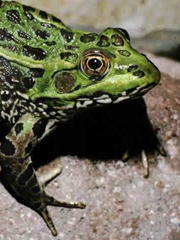|
CHIRICAHUA LEOPARD FROG } Rana chiricahuensis

|
RANGE: Desert and mountain streams and wetlands in central and southeast Arizona, southwest New Mexico, and northern Mexico
STATUS: Threatened under the U.S. Endangered Species Act; categorized as Vulnerable by the International Union for Conservation of Nature
THREATS: Destruction of vegetative habitat by livestock; conversion of natural springs, pools, and wetlands to stock tanks; introduction of exotic species to cattle stock tanks; nonnative predators; water pollution; disease; drought; floods; groundwater pumping; isolated populations; and small numbers of individuals
Though they rarely exceed five inches in length, male Chiricahua leopard frogs are scrappy for their size – they’ll engage in frog-fisticuffs with other males to secure the best territories during the mating season. Females are otherwise occupied: They lay as many as 6,000 eggs during each mating season of their 18-year lifespan. Chiricahua leopard frogs need permanent water for reproduction, but that’s increasingly hard to come by; the riparian areas they live in are often destroyed by livestock grazing, groundwater pumping, water diversion, and dams. The Center for Biological Diversity fought for protection for this species, and in 2002 it was officially listed under the Endangered Species Act – but without protected habitat, these frogs are still at risk.
LEARN MORE ABOUT THE CHIRICAHUA LEOPARD FROG
|